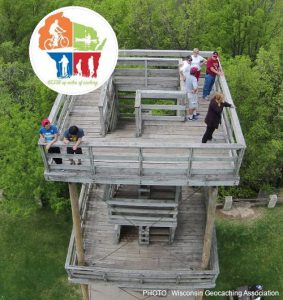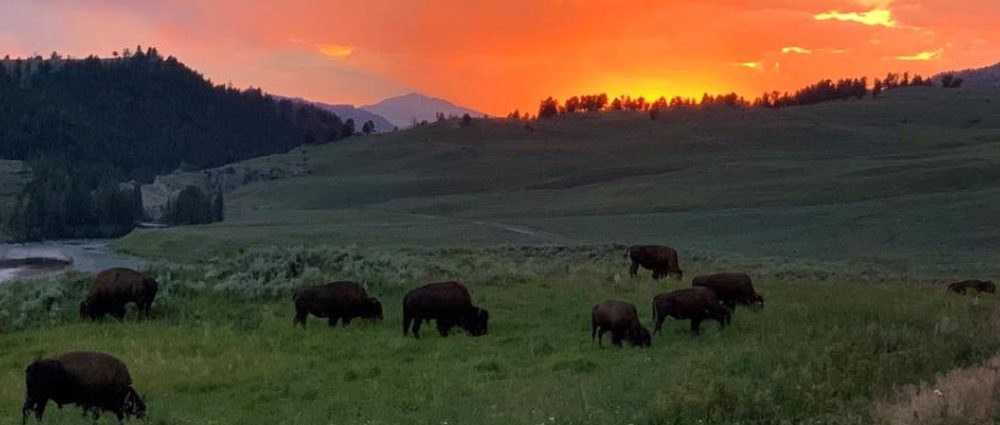 By Erica Howe – By Erica Howe – The Driftless Area is renowned for beautiful natural spots, both on and off the beaten track. But how to find the waterfalls, groves, rock formations, and prairie spaces that aren’t on any tourist maps? Well, there is an activity that can help with that. Geocaching is a sport wherein a cache is hidden (anything from a capsule the size of a pinky to an old ammo box) for people to find using an app on their smartphone. These caches hold lists of the people who have found them, trinkets, or travel bugs (small tagged items that geocachers can take to another cache and leave, tracing their trip via a code on the smartphone app). Of course, the sport didn’t start out this tech-savvy. The first cache was an old coffee cup in Seattle, Washington in 2000, and a handheld GPS was needed to find the cache. Because the sport is so young, people are drawn to it for a myriad of reasons, none of which include tradition. The Wisconsin Geocaching Association had one of their membership meetings in Hillsboro this year, and it was well-attended. Part of the reason for this may be that membership in the association is free. The group’s work is funded by merchandise sales and fundraising events such as chili cook-offs. People came from all over the state to meet with fellow geocachers, even a couple from North of Green Bay. In fact, they had driven over three hours to be at the gathering! I had the opportunity to attend this meeting and visited with some of the members.  This Northern Wisconsin couple, Barry and Val, has been geocaching for sixteen years. They started when Barry needed to test a new GPS system for the fire department, and enjoyed the “underground sport” so much that they’ve found over 11,400 caches in the intervening time. They’ve found caches in old copper mines in the Upper Peninsula of Michigan, and even in National Parks. They are especially glad of the geocaching in touristy places where, Val says, they are able to find amazing sights off of the beaten track, such as old cemeteries and mud vents in Yellowstone. The couple enjoys going after a type of cache known as an ‘earth cache’, wherein you must take pictures and answer geological questions to prove that you found the area. For such caches, it is the area itself that is the prize. Such caches can roam from old walls and bits of buildings to beautiful waterfalls. This Northern Wisconsin couple, Barry and Val, has been geocaching for sixteen years. They started when Barry needed to test a new GPS system for the fire department, and enjoyed the “underground sport” so much that they’ve found over 11,400 caches in the intervening time. They’ve found caches in old copper mines in the Upper Peninsula of Michigan, and even in National Parks. They are especially glad of the geocaching in touristy places where, Val says, they are able to find amazing sights off of the beaten track, such as old cemeteries and mud vents in Yellowstone. The couple enjoys going after a type of cache known as an ‘earth cache’, wherein you must take pictures and answer geological questions to prove that you found the area. For such caches, it is the area itself that is the prize. Such caches can roam from old walls and bits of buildings to beautiful waterfalls.Like Barry and Val, the next couple, Diane and Jack, are retired. They also use geocaching as a way to spend time and explore during vacations in places such as Arizona and Utah. They explained that geocaching was a fun way to meet people, both by finding their caches and by going to meets like the one in Hillsboro. In fact, Diane says that the most interesting part of geocaching is the people she has met, indeed, sitting at the same table was a man they had become friends with through geocaching, though they rarely met beyond the different meets. Geocaching is an international sport, from Canada and the U.S. to Germany and England, so the couple have also met people from many different places. Diane seems to be the instigator, having found her first cache in 2001, and then telling her husband “I’ll buy you breakfast if you go geocaching with me.” She says that geocaching keeps her active, though perhaps a little more so than her body actually wants; some caches are up in trees that she says she maybe shouldn’t be climbing, and people have gotten badly hurt while geocaching. But she’s been fine so far, and the fun is worth the risk. The danger that comes with geocaching isn’t just the height of trees, prickly plants and stinging nettles. You need to keep your phone charged and make sure you can find your way back once you find the geocache. You don’t want to be five miles from the road and have your map disappear. It’s also smart to keep some bear spray with you. One geocacher said he once found an ammo box pulled down from a tree, contents scattered. When he was able to find the lid to put back on the box, he noticed that the holes had been made by a bear’s teeth as it looked for food. So, bring the necessary equipment with you and have a good time, like Renea, who has been on the Wisconsin Geocaching Association board for eleven years, going into her twelfth. Geocaching since 2004, Renea has found over 13,000 caches in her 16 years participating in the sport. She got into caching at a conference she attended in Charleston, South Carolina, when she saw some friends of hers who told her “you’ll never find anything.” With the Driftless spirit to prove that she could, in fact, find something, she went to buy a handheld GPS, printed out some coordinates, and explored the park with a friend who was also new to the sport. They found caches in a lighthouse, an old pirate cemetery, and in 23 other places. Renea says that she was surprised by how geocaching can teach you the history of the area. Not only do caches lead you to cemeteries, but also to historical markers and plaques. This is how she discovered that it was a chair factory in Wisconsin that had founded the Paramount Record company. She found this on a trail along the Mississippi river, the kind of trail made for heavy foot traffic. If that is the kind of geocaching that seems more your speed, there are difficulty ratings on the app for both terrain and placement of the cache, as well as the size of the cache, since some people get frustrated with the near futility of finding the micro-caches no bigger than a couple of centimeters. Renea has geocached in London and Paris as well as all over the U.S., and has met many international travelers at an event that she refers to as the ‘geocaching woodstock’. She says that the only barrier in such events is one that leads to laughs: the metric system versus the U.S.’s convoluted system of feet and yards and miles. It is not easy to discuss distances, or indeed to make the calculation in one’s head. In fact, like scientists, some geocachers give up on the imperial system entirely while participating in their sport. After the event, I went out with Charlie and his mother to find some quick caches that had been set up by the event. Charlie was about four or five, and full of energy. He was also in a unique position (close to the ground) which made finding the cache hidden at about his eye-level easier to find. He was also full of energy, and excited to find the small micro cache. His mother explained that he was always this full of energy, and that geocaching was a good thing for them to do together that wore him out faster than it did her. Geocaching is a fun thing for the family to do together, not just because it’s good exercise and can bring you to beautiful natural spots. There is an initiative called ‘cache-in, trash-out,’ which encourages geocachers to bring bags with them to pick up litter on their explorations. Helping the environment in this way helps to keep our beautiful natural areas clean of trash. Leaving a place better than you found it isn’t just an idea for Earth day, and the sides of roads are constantly being used as dumpsters by people who just can’t wait for the next gas station to throw away their trash. Geocachers are able to help keep areas clean, and that is a good idea for our children. Geocaching may very well become a multi-generational activity, as Charlie was far from the only young child at the meet, though most in attendance were retired. This is a sport anyone can participate in, especially if they have access to a smartphone. And it’s a sport to watch, since it’s still in its infancy and may very well boom in the coming decades to something more than the ‘underground sport’ it is still sometimes seen as. |
2021-03-21


